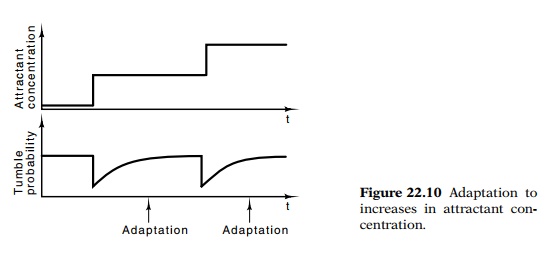Chapter: Genetics and Molecular Biology: Chemotaxis
Adaptation
Adaptation
Many sensory systems in animals adapt to a stimulus. That is, excitation with a particular stimulus will evoke a response, but the response weakens with continued application of the stimulus. An increase in the exciting stimulus will then produce a new response, but eventually a new adaptation occurs (Fig. 22.10). Such an adaptation phenomenon is also observed in bacterial chemotaxis and is inherent in the machinery a cell uses for comparing attractant concentrations at two different times.

Excitation and adaptation can be simply generated
by comparing the sensor’s present signal to some average of the signal over the
recent past (Fig. 22.11). Such averaging is equivalent to a slow response, and
this provides the cell’s “memory.” Hence the instantaneous conditions
sur-rounding a cell must be compared to an average of the conditions taken over
the previous few seconds. If the concentration of attractant has increased
during that interval, the instantaneous signal will exceed the average signal,
and the comparator should produce a signal that sup-presses clockwise rotations
generated by the flagella motors. If, how-ever, the concentration of attractant
has not increased over an interval of a few seconds, the instantaneous and
averaged signals will be equal or negative and the comparator signal will fall.
Consequently, the motor will be permitted to reverse direction at its natural
frequency. In such a direction reversal, the bundles of flagella come apart,
and the cells tumble and randomize their subsequent swimming direction.
Figure
22.11 One circuit that will generate a
response usable for chemotaxis.The comparator response regulates the direction
of flagellum rotation.

Related Topics